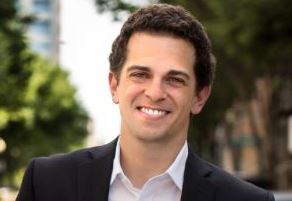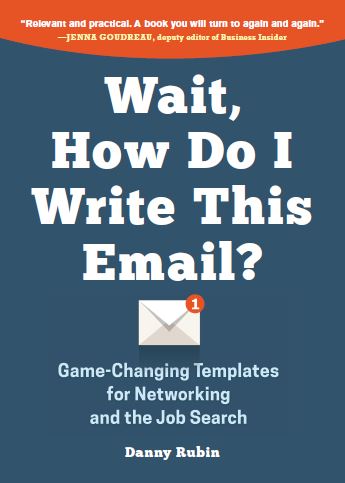The Power of a Storytelling Cover Letter: Q & A with Danny Rubin
Since taking office in June, I’ve had the chance to hear from many of you about your career development questions. You have asked me about resumes; how to find internships, (hint: start with the Internship Center); and writing cover letters. Actually, I’ve received more questions about cover letters than anything else.

I took your questions and concerns to communications expert and author Danny Rubin, who takes a creative strategic approach to cover letters. Here’s what he had to say.
1. What strategies do you suggest students use to make their cover letters stand out among those from other applicants?
The best approach to a cover letter is to catch the reader by surprise. Employers review so many cover letters and expect them to all look and feel the same. If yours has a unique twist that also demonstrates why you’re right for the job, it can make a huge difference in the hiring process.
2. You’ve mentioned you’re a fan of the storytelling approach. What is that, and how can students begin implementing it into their cover letters?
Storytelling is the number one way to stand out in the job market, and I break down the strategy in Wait, How Do I Write This Email?, my new book of 100+ email templates and writing guides.
Here’s what you do: begin the cover letter with a story of success on the job (or from an internship or volunteer opportunity). Prove you have ability, drive and determination through a memorable anecdote. The opening paragraph contains the story and then in the second paragraph you introduce yourself. By then, the employer is (hopefully) hooked and will read the cover letter all the way to the end — and think you’re a rock star.
3. How long do you recommend students tell their story before discussing why they want a certain position? Is there a perfect length?
The ideal length is three quarters of a page. If you go by the template I provide (see below), you’ll find this is the appropriate length to tell a great story, introduce yourself, prove you’re interested in the company and wrap everything up.
4. I’ve always heard cover letters should say why you want to work for a company and what you hope to learn from a certain internship or job. Do you agree with this? If so, how do you recommend students structure their letter to prioritize more important sections?
YES. The other critical aspect of a winning cover letter is to prove through specific examples why you want to work or intern at a certain company. To do that, visit the company’s website and read about recent projects and/or successes. Then, reference one or two of those examples in the cover letter, which shows you made the letter unique to that particular employer and didn’t send the same document to 50 or 100 companies. Authenticity builds trust and makes you look wise beyond your years.

5. Are there certain buzzwords and phrases that students should use or avoid in their cover letters?
So many. You can wipe out almost every predictable adjective with one great story in the opening paragraph. Words like driven, dedicated, motivated, energetic, enthusiastic…delete them and replace with an example of how you act out those buzzwords. That’s why a story is so crucial — it does all the selling for you. Leave the buzzwords to everyone else.
Below is the outline and template for a storytelling cover letter. It’s found on pages 197-199 of my book.
The Power of a Storytelling Cover Letter
An effective storytelling cover letter contains the six parts listed below.
PART 1: Open with a line that places readers into the story. Grab their attention and make them think, “Hmm, this is different. I want to know more.”
PART 2: Include concrete details about the story. The more specific you are, the more colorful the anecdote. Provide hard numbers when appropriate and give exact locations and job titles.
PART 3: Demonstrate how the story applies to the job you want. Refer to the job description and make sure the anecdote reflects the person the company wants to hire.
PART 4: Show you researched the company and understand its opportunities in the broader marketplace. Also explain how you will help the company grow its business. Ultimately, managers want to know how you will make the company more successful.
PART 5: Share more of your qualities as they relate to the story at the top. Again, reference the job description, touch on qualities you know the company admires and show how you would be a good cultural fit.
PART 6: Mention your story one final time and bring the cover letter full circle.
Example of a Storytelling Cover Letter for a Recent Grad
[“Dear Mr./Ms. ____” or “Dear Hiring Professional” if you can’t find the right person],
PART 1: I looked up at the sky and couldn’t believe it: storm clouds.
PART 2: For months, my team and I had prepared for the annual Big Nonprofit Association charity bash, in which students throw a party for 24 hours straight and raise money for children’s hospitals. We had the campus quad reserved and the event ready to go. Then, out of nowhere, a huge thunderstorm threatened to ruin everything.
As team leader, I organized our group to take the dance party inside the gymnasium, notified all participants about the location change and worked with an audio/visual tech to ensure the music played indoors. Within three hours, we had the Big Nonprofit Association party back on track and, in the end, collected $11,000 for charity, the most we had ever raised.
PART 3: My name is Jennifer Sutherland, and I want to be your next program associate. I know it can be challenging to organize, plan and execute big events, and I am ready to work hard for the [name of organization]. Issues and setbacks can appear without warning, and it takes determination to work through them.
PART 4: As I researched your organization, I learned a great deal about the inspiring work you do with the Little Nonprofit Association and its annual fundraising walk that supports cancer research. I also read about challenges in the nonprofit sector. For people to donate today, it’s essential to reach them in meaningful ways, particularly online. I have experience building community and generating buzz on social networks and would do my best to bring fresh thinking to the table.
PART 5: Above all, I am excited to take my hands-on skills in social media and event planning and put them to use for your organization. I enjoy being part of a group, know how to multitask and always finish what I start. I also try to be curious and would want to learn as much as I can from your team.
PART 6: The Big Nonprofit Association party taught me the importance of quick decisions and staying focused in a hectic situation. I am ready to bring the same work ethic and energy to your organization.
Thanks so much, and I hope to hear from you soon.
– Your first and last name
Deeper Insight
If you’re a recent grad, you don’t need actual job experience to impress an employer. Think back on your college years, internships and part-time jobs and share a story to prove your ability. Remember: let the story do the selling!
—
Danny Rubin is a communications expert and author of the new book, Wait, How Do I Write This Email?, a collection of 100+ templates for networking, the job search and LinkedIn. Read more of Danny’s insights on his blog, News To Live By, which highlights the career advice in the latest headlines. You can also follow him on Twitter at @DannyHRubin.
